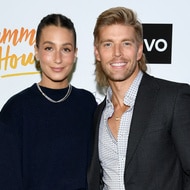The Critic
Francis debates what makes a good critic -- and a good dish for that matter.

So Curtis is standing there, dashing in his chef’s whites, cooking for Kerry and Chris and saying, “I, like you guys, have spent my entire life watching critics at my tables in the restaurant, thinking, ‘It’s so unfair that chefs get judged by someone who knows less than them. They don’t go to culinary school. We do.’ But then I sit at a table with Ruth and James and hear the wealth of knowledge they have. . .”
OK, first of all, WHAT AM I, CHOPPED LIVER?? Ahem. And I did go to culinary school! (Class of ’03. Go Blades Steels.) Now, is it necessary for a food critic to go to culinary school or to have worked as a chef? That’s a philosophical debate -- I mean, should critics “educate” the public, or should they represent the average diner? (Either way, neither James nor Ruth went to culinary school, and they know as much about food as anyone.)
But, for me, that training was like learning a language, a totally different way of thinking about food. Not that it made me clairvoyant, but I can understand the basic cause-and-effects of how a plate is made. As Kerry says, it’s about being “able to deduce what happens in a dish.” And when you can understand those things -- or try to, anyway -- you can read a little into the chef’s intentions and see how they did. You poach, for instance, for tenderness and clean, clear flavor. You sear for browning and complexity. So you can start to evaluate the dish by seeing where the chef was trying to go, and whether they got there.
Still, that’s only one way to evaluate a dish; it’s technical. The meaning, the soul of a dish can be found somewhere else, and that’s why this last challenge was so compelling. Look, Chris and Kerry made it to the finals; we already know they’re great technicians. Asking them to cook a meal that represents four emotions and four relationships isn’t just asking them to sear scallops well, it’s asking them to tell a story.
And no story is ever truly finished by its author -- it takes an audience to read it, to interpret it, to make meaning of it. So I loved hearing what this table full of critics had to say. Alan Richman, with his decades-worth of knowledge of the chefs who paved the way for today’s hotshots. Karen Brooks, whose grown-up punk rockiness I adore. Lesley Bargar Suter, who dares you not to crush out when she sasses about what it takes to get on base with her. Jane Goldman, whose toughness and smarts helped her build one of the internet’s great food communities. And speaking of tough, there was John Curtas, the pugilist-at-table, and across from him, Golden Boy Alan Sytsma, who could sweet talk the pants off of any beef heart. And of course Curtis, Ruth, James, and Krista, who you all know and love.
The chefs, just slaying their dishes in the kitchen, looked out to the room and fretted about who they were cooking for. They didn’t need to. They both cooked fantastic food that told genuinely moving stories: Stories about love and sacrifice and an unearthly commitment to their craft that can hurt the people around them. I think, in retrospect, gathering that table of pros wasn’t about intimidating them. It was about finding the most insightful audience for their work, people who will see what this means, who will, who must, now understand where they stand. Putting that table of critics before these chefs, really, I think, was a tribute to them.



